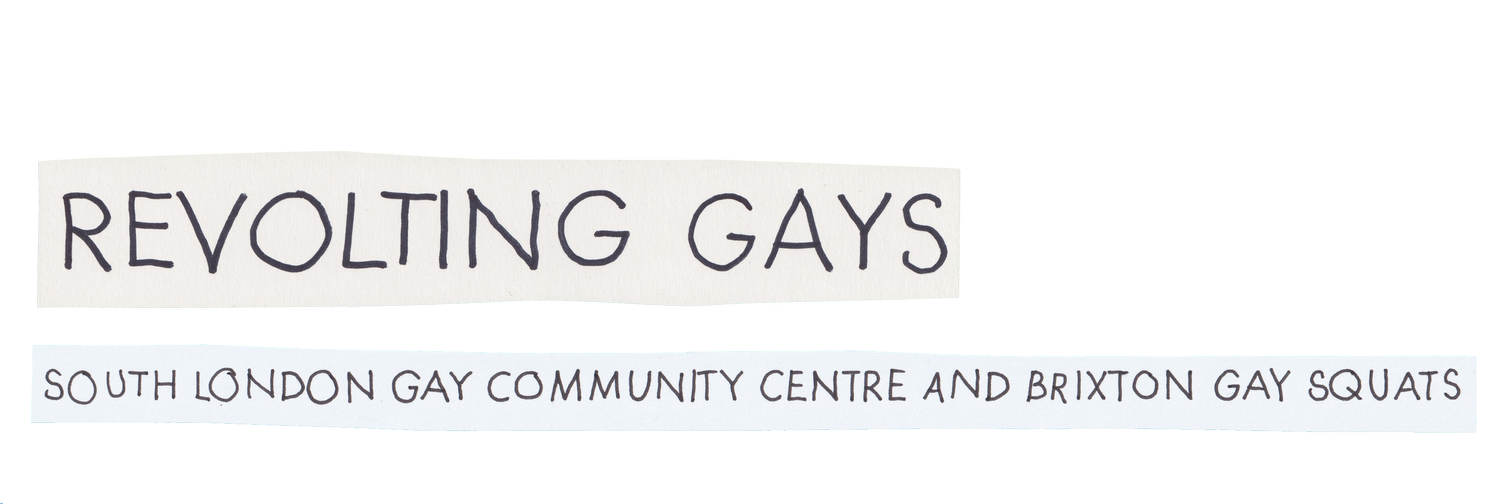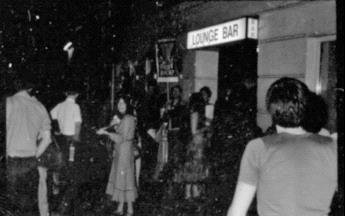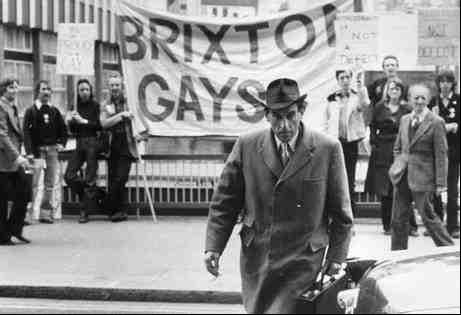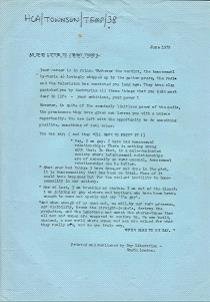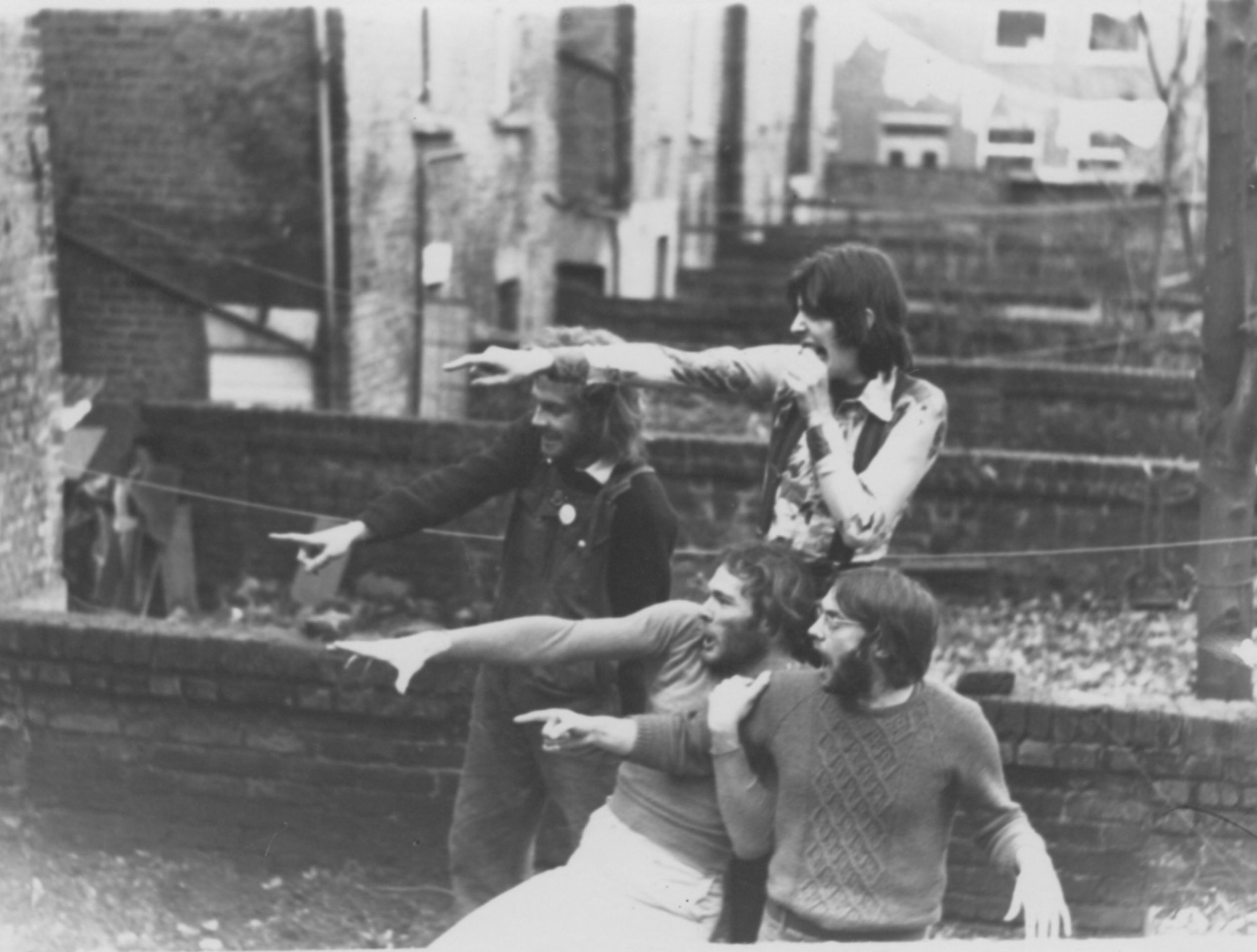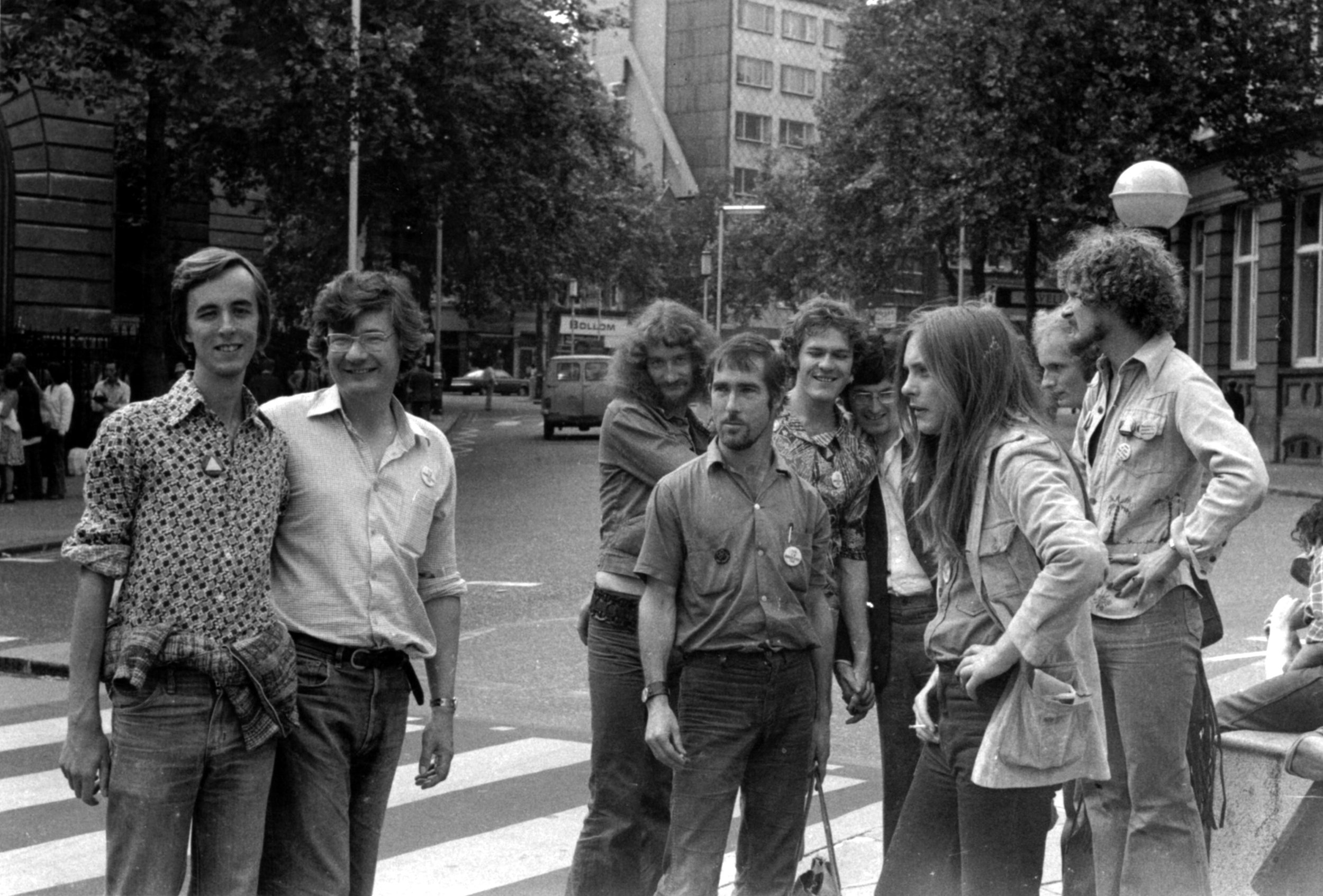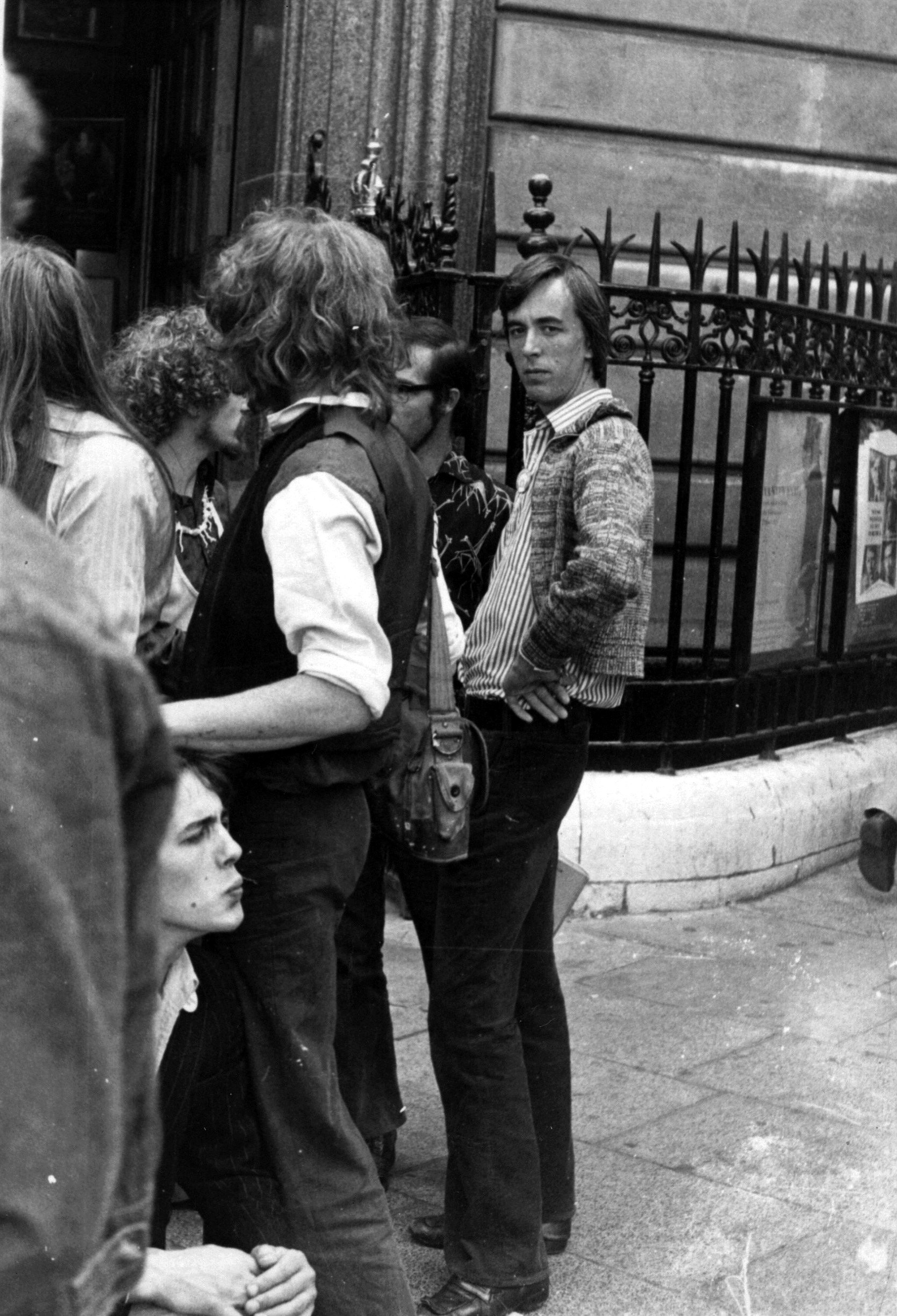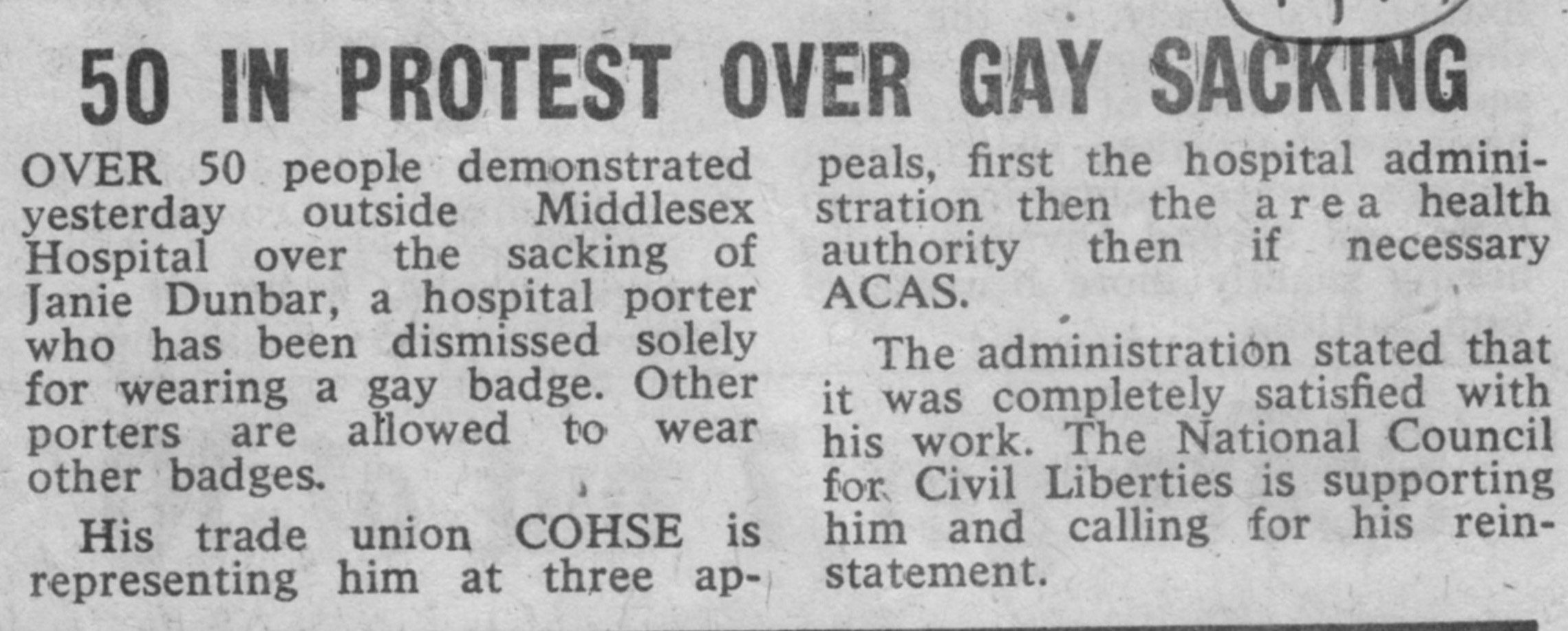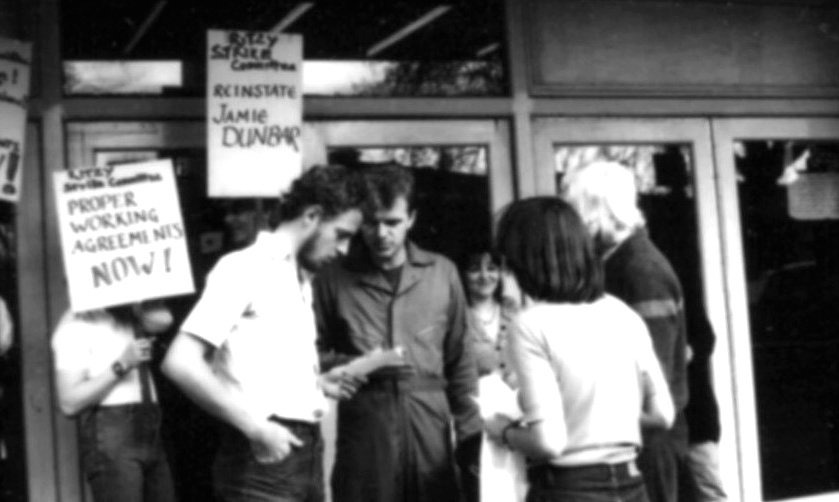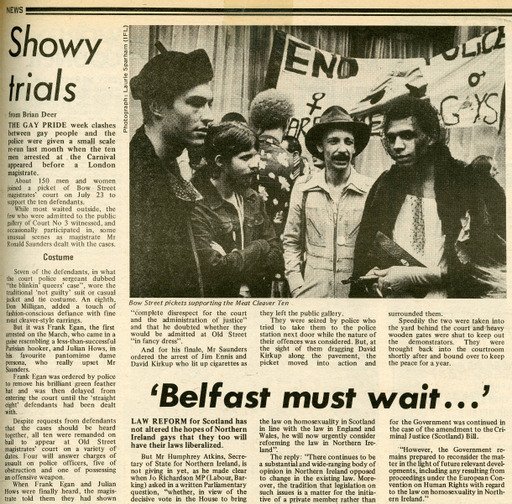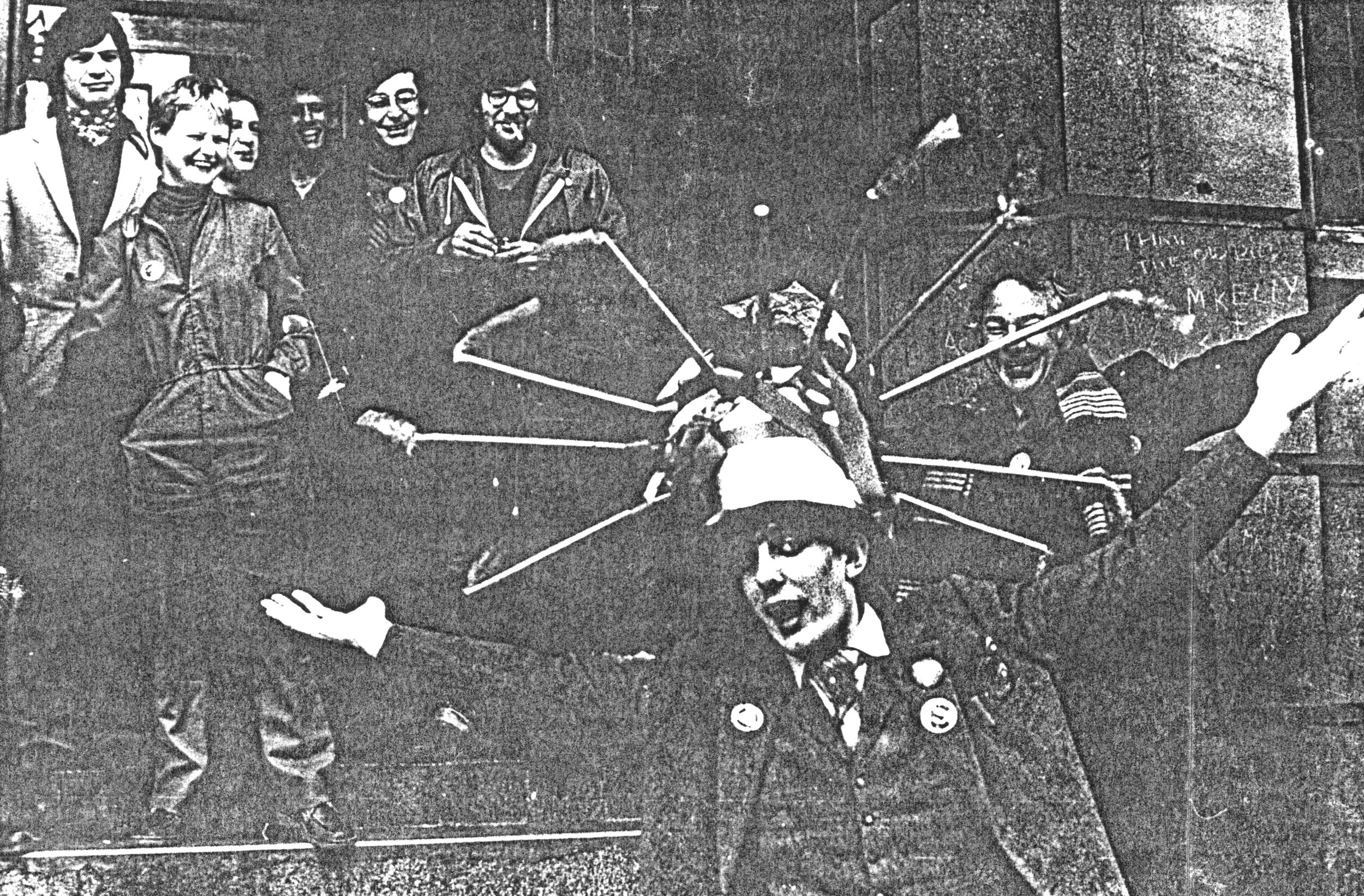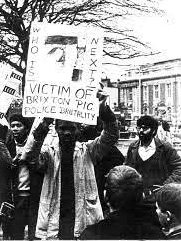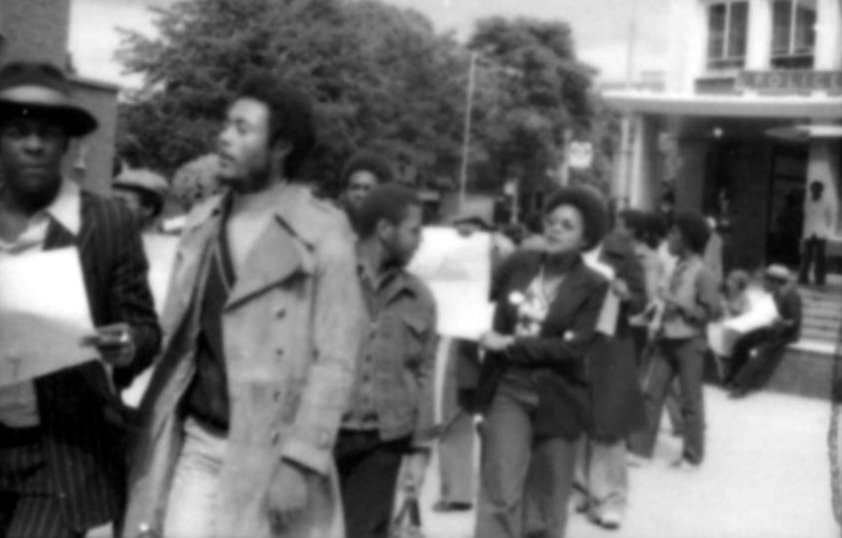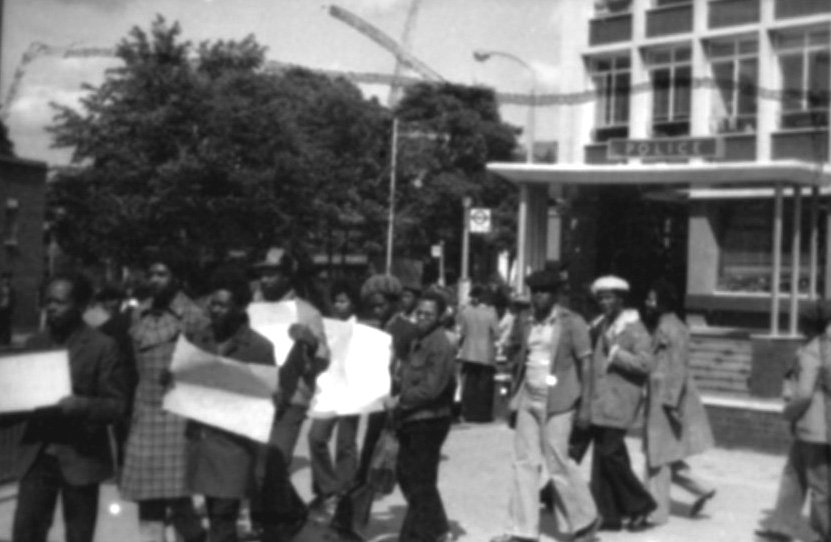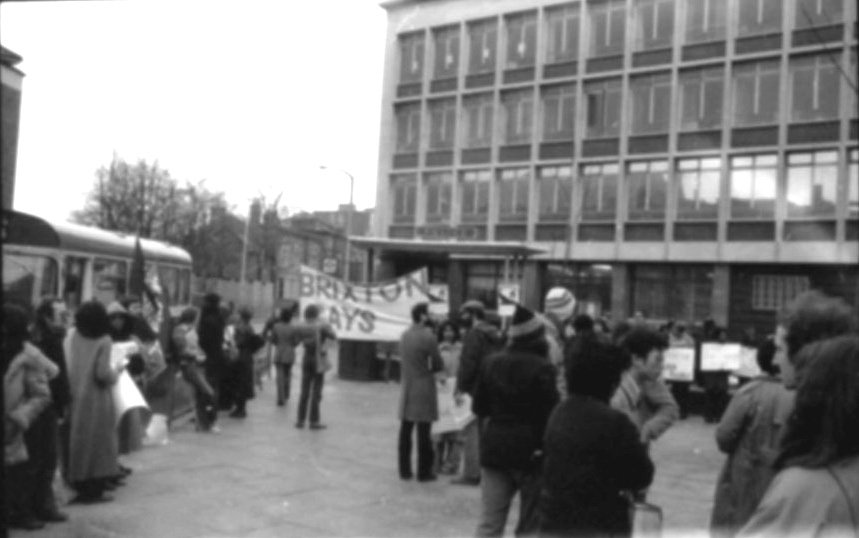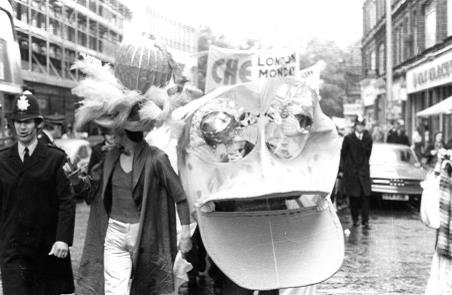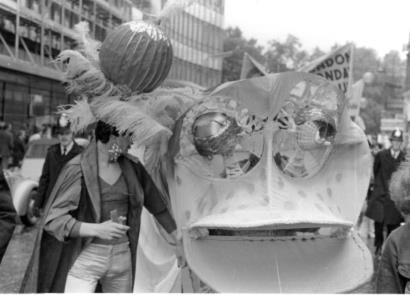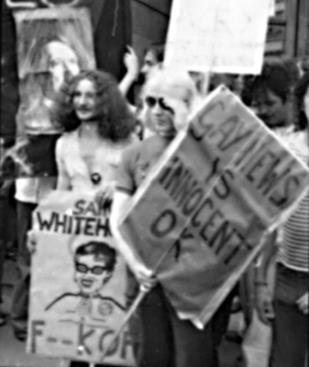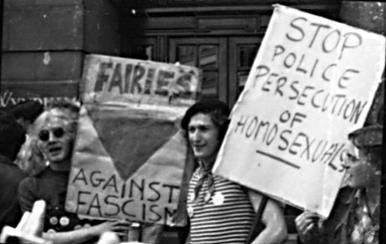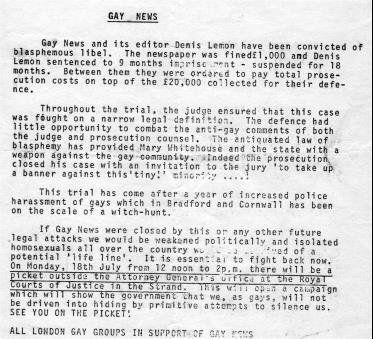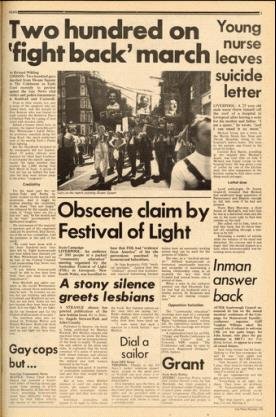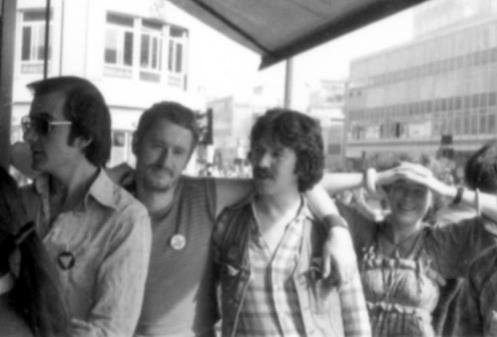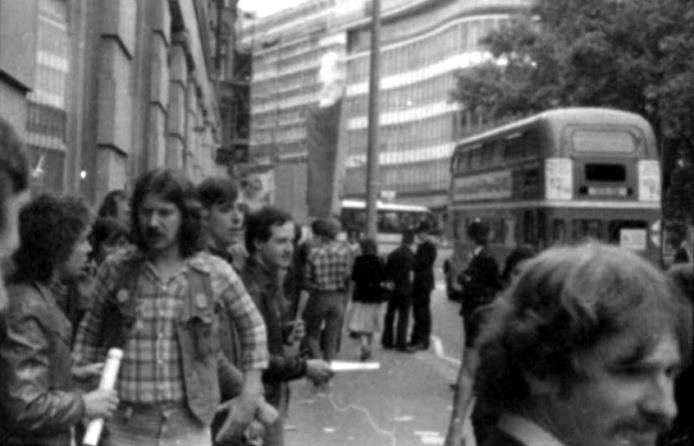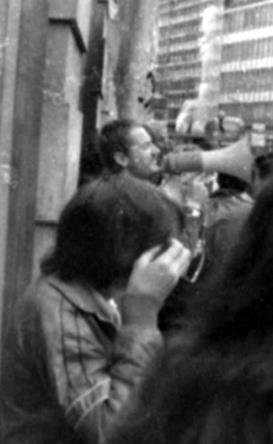


People from the Brixton Gay Community participated in several campaigns. We even created a few of our own. Here are some examples:
BRADY’S BAR BANS LESBIANS
Ian Townson holding placard
This picket outside the entrance was there to demand a boycott of the pub for banning lesbians. We were joined by other members of the community demanding their reinstatement (late 1970s).
Ashley McKay on the right sister of David. Both worked at Union Place Community resource Centre as did Colm Clifford and Ian Townson
The Railway Tavern on Atlantic Road (now a branch of a Mexican-style restaurant), better know as Brady's after the name of the landlord, was the watering hole for LGBT+ people, socialists and Revolutionary Left organizations.
The manager of Brady’s on the right looking bemused at all the picketers
The Railway Tavern on Atlantic Road (now a branch of a Mexican-style restaurant), better know as Brady's after the name of the landlord, was the watering hole for LGBT+ people, socialists and Left organisations. This picket outside the entrance was there to demand a boycott of the pub for banning lesbians. We were joined by other members of the community demanding their reinstatement (late 1970s).
LAMBETH COUNCIL REFUSES GRANT TO SOUTH LONDON GAY COMMUNITY CENTRE
Lambeth Council refused to award a grant to the South London Gay Community Centre to cover basic running costs for rent, rates (community charge) and electricity. Among those objecting to the grant was Mrs. Beatrice Old, the landlady of the George public house, from which we had been barred. The grant application for the Gay Centre and the Women's Place next door were considered together. The Council insisted there would not be sufficient revenue for either organization though later they agreed to a grant for the Women's Place.
We plastered this poster around various locations in Lambeth as a protest against the decision and converted Lambeth Town Hall's fine old Edwardian clock tower to a fuck off 'V' sign leaving no doubt as to our feelings on how the council had treated us (1975).
BRITISH MEDICAL ASSOCIATION CONFERENCE ON PYSCHO-SEXUAL DISORDERS ZAPPED (1974)
This 'zap' of the BMA conference was where I first met Colm Clifford and Gary de Vere from the South London Gay Liberation Front. Colm invited me down to London and a month later (October 1974) I moved into one of the Brixton gay squats. From the frying pan of a relatively simmering sizzle in Lancaster to the fiery maelstrom of political activity in Brixton (Ian Townson).
This 'zap' of the BMA conference was where I first met Colm Clifford and Gary de Vere from the South London Gay Liberation Front. Colm invited me down to London and a month later (October 1974) I moved into one of the Brixton gay squats. From the frying pan of a relatively simmering sizzle in Lancaster to the fiery maelstrom of political activity in Brixton (Ian Townson). Here is a transcription of one of the articles below, author and publication unknown (1974):
Gays take over doctor's congress: BRADFORD: First it was Levis, then it was hamburgers, and now British gays have imported the American 'zap'. Sixty gay women and men moved in on the British Medical Association 'Congress on Pscyho-Sexual problems' to demand, among other things, that delegates discuss with them the subject of homosexuality and other related topics.
"The whole thing went like clock work," said one of the gay demonstrators afterwards. "It was just better than anything we had hoped for in our wildest dreams."
The whole episode started several weeks ago when it was first learnt that a congress was being organized, and would be held at Bradford University. Members of Bradford GLF were annoyed to see subjects such as homosexuality, transvestism and transsexualism down on the agenda for a medical conference on "Psycho-Sexual Problems."
"Homosexuality," said Don Milligan, a member of Bradford GLF and one of those responsible for the zap, "is not a medical problem. When are they going to get that into their heads. Of course doctors are concerned with homosexuality because those homosexuals who have anxieties about being gay will often go to the doctors in the first instance. But if doctors are going to be able to give proper advice then they need help and guidelines from gay people."
Other gay groups were alerted. A leaflet went out, noting that the conference was being sponsored by Geigy Pharmaceuticals a drug company which manufactures Anquil (benperidol) a drug to eliminate sexual desire in the recipients. A disco was arranged for the Thursday night of the conference for any gays who wanted to attend.
At 6.00 on Thursday evening when most of the demonstrators had arrived in Bradford, a planning meeting was called in the University building on the floor above the BMA conference hall. Groups represented at the meeting included Bradford Lesbian Group, Bradford CHE, Bradford Socialist Women's Action Group, Leeds GLF, Manchester Lesbian Collective, Manchester GLF, South London GLF, (Lancaster GLF - omitted in report) and CHE activists. Letters of solidarity were received from Bristol Gay Awareness Group, Sussex GLF, and Edinburgh Science for People, among others. After this they had a very well-attended disco in the Bradford Students' Union.
The following morning, Friday 13 September 1974, demonstrators atarted arriving at the Students' Union at 8.25am. At 8.50 sixty people headed for the conference hall via a linking corridor between the Students' Union and the main building.
Between the conference hall and the corridor was a large ante-room connected to the conference hall by a narrow passage. At the doors to the ante-room, two university proters checking delegates passes stopped the gay contingent and held the doors against them. Demonstrators said they had agreed at their planning meeting that no sort of force must be used against the porters, so they stayed quietly at the door negotiating with the conference organizers. BMA delegates were effectively prevented from entering the hall by the gay groups who were blocking the doors.
At 9.00 a number of university cleaners arrived to collect their weekly pay from the Cashiers' desk situated in the ante-room. At first they were kept out by the porters, who had been instructed by the organizers to let no one in. But the demonstrators let them through to the front of the crowd in the corridor, and after repeated chants of "Let them through," the women were allowed to duck under the porters' arms and collect their money.
Two of the cleaners who had been talking with a GLF contingent told Gay News that they thought the gay group should be allowed in.
Acting as a go-between, Professor Tom Stoakes of Bradford University suggested that the gays be allowed into the conference to take part in the discussion. The organizers turned them down. They said they could let three gay people in, because there was not enough room for everyone. But this was turned down flat by the demonstrators. Don Milligan pointed out that "three people did come in a day or so ago quite quietly, and sat down quite quietly, and didn't heckle, and behaved themselves - and we....
(the rest of the article is missing. I will try and trace its whereabouts)
Don Milligan addressed the conference after it had been taken over by gay liberationists. Here is his account of the zap:
“The criminologist. Oh yes, yes! There was an international conference on psycho-sexual disorders held at the University of Bradford. The local gay group....we decided that we couldn't allow this and we would have to do something about it. The conference was to last for a whole week and we thought how should we get into it. So we decided that we would picket it everyday and leaflet it and have a bookstall outside it to lull them into a false sense of security so that they would think that this is all that we are doing and so on. So that's what we did and then on the final day, the night before the final day, the Thursday night, we organised a big gay disco to which we invited people from all over the country. Loads of people came and I remember Louise Hart was in charge of organising
Weetabix in the morning. Because she had to get everybody up at the crack of dawn before we broadcasted it?
We then went to unveil our plans in martial spirit about how we were going to invade the conference hall and occupy it. This is in fact what we did. The high court judge who was supposed to be chairing the session on psycho-sexual disorders and about homosexuality nearly bust a gasket. All the men were in frocks and the women were in various kinds of outfits except for lta Casey, I remember, who was an Irish catholic woman mother of several children, a wonderful dyke, who insisted on having a great mass of peroxided hair and a large patent leather handbag. Very conventional clothes. She always took down the details of all our meetings and activities in her catholic diary. lt was there and of course in all her
conventional clothes she looked like a man in drag (laughter). She was such a conventional figure.
I had a long, blue velvet gown with a sequinned top and a clutch bag and a fur cape. We broke up their conference and we zapped it in the sense that we addressed it. I made a speech at it and the delegates came in and they were furious that they had to participate. Our demand was that they suspend the agenda and discuss homosexuality with us which is in fact what they did do in the end. At the end of that session we then withdrew much to the chagrin of the popular press who were demanding that we should stay because they wanted us to be hauled out by the police and all the rest.”
GAY NEWS, HELMUT’S COCK AND VICTORIAN PRUDERY (1973)
In 1973 Gay News published a pleasantly erotic photograph of Helmut, a male soft porn 'pin up' star. In the following volume his genitals had been censored in the 'fig leaf' Victorian manner using a star shape. This prompted a protest letter from SLGLF member Gary de Vere.
His irritated 'What on earth is the matter with you' stance prompted him to wonder if Mary Whitehouse or Lord Longford, two religious moral watch dogs, had joined the Gay News staff.
Following complaints from readers he attacked the capitulation to 'respectable' standards of 'decency' demanded from people afraid of their own sexuality and questioned whether the majority of readers would be upset 'at the sight of a cock.' He also attacked the implication that there was something 'rather nasty about the genital part of sex.'
He demanded to know how far Gay News would go to accommodate the views of its readers including dropping articles on police harassment because they believed the police were a fine body of men doing a great job in very difficult circumstances.
In the final paragraph, though Helmut was a 'pleasant surprise', he rejected the notion of turning the paper into a 'pin-up forum'. His final comment was a killer: '...the picture in No.27 makes me feel sick...after all some of us have castration worries, and don't take kindly to pictures of mutilated cocks...'
Gay News Volume 26
Gay News Volume 27
SPOT THE DIFFERENCE
GAY PRIDE 1979
Stephen Gee and Ian Townson advertising Gay Pride 1979 while traveling on London Underground.
Stephen Gee and Ian Townson advertising Gay Pride 1979 while traveling on London Underground.
Stephen Gee and Ian Townson advertising Gay Pride 1979 while traveling on London Underground.
Don Tyler
Colm Clifford advertising Gay Pride 1979 while traveling on London Underground.
Edwin Henshaw along with Don Tyler was jointly responsible for organizing the event.
THE TRIAL OF JEREMY THORPE
Brixton gays picketing the Central Criminal Court (Old Bailey) as Jeremy Thorpe arrives for his trial on the charge of conspiracy to murder
Colm Clifford and Ian Townson worked at Union Place Community Resource Centre where Colm established ‘Homosexual Posters.’ We produced this image on a gay calender and also printed a gay men’s diary, gay-themed Christmas cards and various campaigning leaflets
Leaflet handed out at the Old Bailey attacking the notion of Thorpe’s homosexuality as a ‘fatal flaw’ in his character and exhorting him to come clean and come out loud and proud as gay
The South London Gay Lberation Front and Brixton gays organised a picket of the Jeremy Thorpe trial at the Central Criminal Court (Old Bailey). He was charge with conspiracy to murder Norman Scott with whom he had a sexual relationship. During the trial Thorpe’s homosexuality had been decribed as a ‘fatal flaw’ in his character. The gay liberationists were there to challenge that negative description by urging Thorpe to come out loud and proud as gay now that his carreer as an MP and leader of the Liberal Party was in ruins. Thorpe was found not guilty though it was felt at the time by several observers that the judge had biased the jury in his favour by building a picture of Thorpe as a paragon of virtue against all the other witnesses who were portrayed in wholly negative terms. The judges deliberatlions were famously satirised on television by Peter Cook in the annual Secret Policeman’s Ball (1979).
QUEENS ARE……EVERYWHERE!
Backgroung L-R: Peter Cross, Julian Hows, Foreground L-R: Peter Vetter, Ian Townson
I can’t for the life of me remember what we were meant to convey here. Godzilla on the rampage?
Peter Vetter, Julian Hows, Jamie Hall outside a church on Dulwich Road
Julian Hows
Queens are this, that and the other. The intention was to produce a children's story book designed to challenge tired and oppressive establishment images of and accounts about gay men. The photographs were meant to portray the diversity of different attitudes, appearances and identities. Unfortunately this project didn't come off.
Gary de Vere dressed as a 'schoolboy' outraging public decency by reading a copy of Kake the Leatherman's hyper masculine porn magazine illustrated by Tom of Finland
STEFAN’S CASE AGAINST DEPORTATION
Stefan, who first came into contact with the SLGLF, was originally from Spain and threatened with deportation after living here for ten years. Though Franco was dead the country was ruled by King Juan Carlos and fascism was only slowly giving way to a more liberal regime. Even so a reactionary moral climate and social conservatism still prevailed there and Stefan was terrified that his homosexuality would be discovered on returning to Spain.
Members of the SLGLF and the Gay activists Alliance called for a picket of Pentonville prison where Stefan was held pending his deportation. At the court hearing members of the SLGLF, together with the legal team defending him, spoke up in his favour and secured his right to stay.
Bill Thornycroft recalls Stefan’s defence:
“Stefan's threatened deportation? I went to the court case. I was one of the guarantors or sureties or whatever you call them and Gary (de Vere) was. There was this wonderful meeting with the adjudicator or whatever you call him. Sort of judge who decides. Stefan made this incredible speech about how he was in danger if he went back to Spain. How he loved England and England was the most wonderful place. The most wonderful place and the only place more wonderful than England was perhaps, but only perhaps, heaven. I thought...my god, he's going rather over the top on this. It worked. He was allowed to stay (laughter). It was an immigration court or something maybe in the Strand.
WRITERS OF THE 1930s
L-R: Stephen Gee, Jonathan Cutbill, Edwin Henshaw, Gary de Vere, Peter Vetter, Peter Bradley, John Lloyd, Paul Newton, Alastair kerr outside National Portrait Gallery
Stepehen Gee looking mean and determined and Julian Hows blowing a kiss
Stephen Gee and Jonathan Cutbill
An exhibition about writers of the 1930s was held at the National Portrait Gallery from 25 June to 7 November 1976. The writers included W H Auden, Christopher Isherwood, Cecil Day Lewis, Louis MacNeice, and Stephen Spender. Besides photographs there were unpublished letters which illustrated each writer’s reactions to political and literary events and manuscript drafts of published and unfinished work. What he exhibitioon failed to acknowldge was the fact that Auden, Isherwood and Spender were gay and that their homosexuality was an integral part of some of their writings. Gay Liberationists from Brixton organised a picket of the exhibition to put the record straight! Humphrey, the brother of Stephen Spender, also complained in Gay News that the sexuality of the writers had been sidelined.
NATIONAL FRONT ELECTION MEETING
Demonstration outside the school against the National Front’s election meeting
Alastir Kerr from the Brixton gay community holding a ‘Fairies Against Fascism’ placard
Derrick Day and Martin Webster the National Front’s national activities organizer in the 1970s. He was later expelled from the party when his homosexuality was discovered
Cops and Martin Webster fuming at a demonstrator
Lewisham demonstration against the National Front 1977 where the fascists got beaten off the streets
The fascist National Front held a local election campaign at a primary school on the Angell Town estate, Brixton. The meeting was picketed by local left and trade union organisations along with community groups, women's groups and gay liberation. The NF were racist, anti-gay, misogynist and in favor of dictatorship against democracy. Typically they chose an area with a high black and ethnic minority population to stir up trouble and provoke a confrontation (1976)
QUEENS IN FURS: SUMMONED TO CAMBERWELL MAGISTRATE’S COURT
Queens in furs L-R: Malcom Greatbanks, Lloyd Vanata, Ian Townson, Gary de Vere, John Lloyd and Anna Duhig
David Callow, John Lloyd, Colm Clifford, Gary de Vere
No prizes for spotting the mistake
Quote from taped interview with Bill Thornycroft:
“There were these mass prosecutions for non payment of rates. We were refusing to pay rates because the council refused to give the Gay Centre a grant. In any case we said that as council services were geared towards heterosexuals we weren't getting a fair proportion of services. It also coincided with a lot of other people not paying rates for various reasons. There were so many people being prosecuted they took six at a time. So you had six people standing in the accused position and you had Gary de Vere who was going to speak for David Callow because he had a speech impediment. When David and his six stood up Gary said “I don't know where I should stand because I am speaking for Mr. Callow.” He was standing at one end and David the other of this row of people. He said to the magistrate “Am I in the right place?” and she said “Oh no, Mr. de Vere, I don't think you are. I think you should come up here. It is very important in this court that we should all know our places and be in the right place” (posh, haughty voice). This was so wonderful. An unconscious bit of truth that we should all know our places (in the class hierarchy). Of course we had packed the gallery and they all collapsed in hysterics and the court was threatened to be cleared. Camberwell magistrates court. That's where we all flounced out in our dreadful fur coats that were practically down to the ground. It's a good thing there weren't any animal liberationists about. We'd have been done.
COLM CLIFFORD AND JAMIE DUNBAR SACKED FOR WEARING GAY BADGES
Jamie Dunbar, Peter Vetter, Julian Hows and unknowns outside the Ritzy cinema, Brixton, demanding his re-instatement and better wages and workinsg conditions
Jamie Dunbar looking cool
FRANK WORE A MEAT CLEAVER IN HIS HAT (1980)
Julian Hows’ spinning hat creation
Frank Egan in femme fatale pose except femme fatales they don’t usually hang washing out. to dry
Frank Egan, a member of the Brixton gay community, wore a meat cleaver in his head dress at the 1980 Gay Pride March as part of his radical drag costume. A policeman foolishly arrested him for carrying an offensive weapon. This led to an immediate march in protest against the arrest and the beseiging of the police station where Frank was being held along with others who had also been arrested. Fearing a confrontation they were released and later they were all acquitted.
PICKET OF BRIXTON POLICE STATION
Demonstration outside Brixton Police Station by black activists, parents and friends against deaths in police custody, harassment and intimidation by the police. Early to late 1970s
The barely decipherable placards read:
Oppose Police Brutality
End Pig Rule
Police Muggers Out
Go To Hell CCRL
(Council for Community Relations Lambeth)
Pregnant Woman's Death By Police.....
Deaths and beatings in police custody and harassment, arrest and false imprisonment at Brixton police station of mostly black youth were met with resistance from local black activists and the parents and friends of those who had been falsely accused and detained under the stop and search ‘sus’ laws. Brixton gays, also harassed by the police, joined the picket in solidarity with protesters and those detained. The Gay activists’ alliance also attended the pickets. These racist attacks by the police against black people had been going on for several years culminating in the Brixton uprising of 1981.
BRIXTON UPRISING (1981)
Remnants of Windsor Castle Pub, one of several establishments that barred us for being openly gay
This was in July 1981, three months after the Brixton uprising, when it was still felt to be unsafe to enter the area after further disturbances caused by police raids looking for stolen goods
William Shelton, Tory MP for Streatham, raised objections in Parliament to the ‘rioters’ and their supporters (see extract from Hansard below).
Three views of the burnt-out George pub after the 1981 uprising; one of the establishments from which we were barred for being openly gay. The publicans were previously prosecuted under the Race Relations Act for barring black people.
The Special Patrol Group, otherwise know as the riot squad, was notorious for heavy handed policing of strikes and demonstrations until it was eventually disbanded because of the level of violence it had meted out. The killing of Blair Peach at an Anti-Nazi League demonstration in Southall in 1979 was the worst example of the groups brutality. The SPG was also mobilised to police areas of high crime and had been active in Lambeth for a number of years especially around Brixton. The military style operations consisted of drop off points where police would disembark to stop and search individuals and groups in the street or raid people’s homes. The local police force had already provoked a reaction from the black community and their allies with the deaths in police custody of black prisoners and the beatings and heavy-handed policing of mostly black youth under the stop and search ‘sus’ laws.
Opposition came in the form of demonstrations outside Brixton police station and a public enquiry on police practices by Lambeth council which was published shortly before the Scarman enquiry into the 1981 rioting in Brixton. The police army of occupation lasted on and off for six or seven years during which time a considerable number of black youths and older black people were the victims of arbitrary arrest, detention, beatings, false imprisonment and deaths in police custody or during external police operations.
The SPG and police from several forces were drafted in to Brixton during the early summer of 1981 at the request of the local police force to deal with the high level of crime in the area. The area was also flooded with plain clothes officers. Called Operation Swamp 81 after Margaret Thatcher’s speech about being ‘swamped by alien cutures’, the police stopped and searched over a thousand people over the space of a week within the confines of the Brxton area alone. Hundreds were arrested. It only took once incident and the cumulative effect of years of racist harssment and brutality from the police to spark off the Brixton uprising of 1981.
The Brixton gay community, in a show of solidarity with the uprising, joined people on the streets at the time issuing a joint statement with the gay section of Brixton Housing Co-op supporting the struggle against racist police, poverty and oppression. The statement, along with others groups supporting the uprsiing, was mentioned disapprovingly in the House of Commons by William Shelton, Tory MP for Streatham. We were castigated for supporting ‘criminal actions’.
WILLIAM SHELTON, CONSERVATIVE MP FOR STREATHAM, CONDEMNS THE ‘RIOTERS’ AND THEIR SUPPORTERS
Hansard: 28th April 1981
Conservative MP for Streatham, South London, Mr. William Shelton
I agree that there has been a strong police presence in the area, and particularly in Brixton. There is a high rate of crime in the area. However, the vast majority of citizens in Brixton are law-abiding and support the police. I agree that there is an unusual level of deprivation in the area. Whether that deprivation takes the form of housing or lack of jobs, the House deplores it. However, no level of deprivation can excuse what happened in Brixton. If any Opposition Member disagrees with that statement I shall gladly give way to him. The environment created a critical mass, such as can be found in other urban centres in England. The detonator was provided by Left-wing organisations which had been working towards that end for years.
I am surrounded by leaflets, which were picked up in Brixton and sent to me as a result of a question that I asked in the House some weeks ago. Some are old leaflets and some are more recent, but they all have similar things to state. For example, the Caribbean Times states:
""Deptford…Police knew it was a bomb.""
In its review the Revolutionary Communist tendency states:
""Police out of Brixton.""
There is an inflammatory editorial inside that paper. The Socialist Worker carries one headline:
""Brixton: black and white unite to fight!""
The "Workers News" states:
""Bring them down … The working class response gathers strength.""
Here is an odd one: It is a
""Joint Statement: Gay Liberation South London Brixton Gay Housing Co-op.""
The statement is unsigned, as many such leaflets are, and is consequently illegal. It states:
""For the past five years the people of Brixton have been the victims of constant police harassment. We unconditionally support the initiative.""
The "New Cross Massacre Inquest" states:
""We know the police will try to cover up the real truth. We know from previous experience not to trust the police investigation … Despite their efforts the police have been unable to come up with a black scapegoat.""
A leaflet entitled "Brixton—The Communist View" states:
""The uprising against police oppression that took place in Brixton has brought forth many explanations.""
The Workers News Group uses the headline "Lessons from Brixton". It continues:
""The spontaneous uprising of the people of Brixton against the intensified police harassment … ""
Even the Council for Community Relations in Lambeth issued a press release——
I said "even" because the CRR is partly funded by Lambeth council. It states:
""CCRL sees the events of last weekend as the inevitable result of long standing and consistently provocative policing policies … the weekend's violence was the only way people could express legitimate resetment at persistent injustice.""
All hon. Members will surely disagree with such a shameful statement. The "Brixton Socialist Worker Bulletin"states:
""Frontline news … No one wants rioting, if there is an alternative. But for many people in this area … there is no alternative.""
A leaflet entitled "Brixton Socialist Workers' Party Public Meeting" states:
""It was a magnificent way for Brixton to fight back.""
I have many more pamphlets, all of which were found in Brixton. Many are given only to coloured youngsters and are often given by white men. Opposition Members may ask what all that has to do with the Labour Party. 'The headline in a leaflet headed "Labour Party Young Socialists" makes the following demand: "Defend Brixton". There is a photograph of Brixton burning. It continues:
""Brixton has erupted with an explosion of pent-up anger. It was provoked by a massive police presence … Responsibility for what happened lies squarely on the shoulders of the police"."
Among its demands are the immediate release of those arrested, the dropping of all charges, the disbandment of the Special Patrol Group and democratic control of the police.
I had expected the hon. Member for Lambeth Central (Mr. Tilley) to be in the Chamber during a debate on Lambeth.
NATIONAL GAY NEWS DEFENCE COMMITTE
Outside the Old Bailey
Banner of ‘Anita Bryant + Mary Whitehouse = Adolf Hitler’. Anita Bryant tried to ban gay teachers and ran a ‘Save our Children’ campaign. Mary Whitehouse prosecuted Gay News for blasphemous libel among other attempts at censorship and Hitler needs no introduction…The banner drew attention to how the exremes of religious moral policing can easily merge with Nazi ideology
This demonstrated our solidarity with working class strike action - see Wider Background section
Our gay dragon originally took part in a local street festival and then graced several demonstrations.
Julian Hows encouraging the hapless creature to stay the pace and keep up with the others as the occupants tread on each other’s toes
Gathering at Trafalgar Square
The Gay Activists’ Alliance inherited a solid nationswide core of local NGNDC groups
Other messages that didn’t quite make it onto stickers:
The Lord is my shepherd and he’s into sheep
Jesus commanded us to love all men
A Whitehouse a day keeps liberty at bay
The NGNDC was formed to protest against the prosecution of Gay News by Mary Whitehouse on the charge of blasphemous libel. The pickets and demonstrations were originally organised by the SLGLF and the Brixton gay community with the HQ in one of the gay squats at 146 Mayall Road. Other groups and individuals soon joined to swell the ranks of protesters.
CHRISTMAS CAROLS FOR MARY WHITEHOUSE
Merry songsters visited the home of Mary Whitehouse to wish her festive good cheer with gay-themed Christmas carols including “A Gay in a Manger” and “Jesus Wants me for a Bum Boy”
Visiting Mary Whitehouse’s home to sing gay-themed Christmas Carols with Terry Stewart looking on
L-R: Stephen Gee, Richard McCance, Ron Grant?, Dave Landau?, Roy Burns?, Terry Stewart
W H SMITH CAMPAIGN
W H Smith, with a near monopoly on newspaper and magazine distribution, banned Gay News from its stores leading to a huge campaign against censorship
Richard McCance took part in Gents a play by Brixton Faeries about cottaging and was the chief officer in charge of the counselling group London Friend. His main claim to fame is as the first openly gay local councillor on Nottingham Council
L-R: Edwin Henshaw, Don Tyler
Brixton gays outside a branch of W H Smith in Streatham, South East London
Carried in a coffin to demonstrate censorship and the death of free speech
W H Smith banned Gay News for carrying an article and contact ads about paedophilia. No members of the public had complained about this and the decision was taken secretely behind closed doors. The Guardian newspaper also carried articles about pedophilia but did not suffer the same fate as Gay News. This constituted a huge act of censorhip given the company had a near monopoly on the distribution of newspapers and magazines.
BRIXTON QUEENS WELCOME PROTESTERS ON ANTI-NAZI LEAGUE DEMONSTRATION 1978
Truck loads of punks and skinheads were bemused by the presence of radical drag Queens as they passed by the gay community squats
Mary Evans Young and Colm Clifford cheering on the procession as it made its way along Railton Road to Brockwell Park for a Rock Against Racism festival
Micheal Kerrigan astonished by the size of the demonstration
Fascist parties and movements were especially active in the 1970s. Notably the National Front and the British Movement. To counter the rise of these violent racist movements for white supremacy the Anti Nazi League was established and was active into the early 1980s. The ANL inspired the creation of Rock Against Racism to capture and engage a more youthful audience. Gay venues such as the Vauxhall Tavern were attacked by the NF and their 1976 election meeting at a primary school on the Angell Town estate in Brixton was picketed and disrupted by demonstrators. South London Gay Liberationists joined the picket line with their banner and ‘Fairies Against Fascism’ placard. In 1977 The NF organized a provocative march through Lewisham in an area with a large black population. The march was disrupted and defeated by opposition from the left but importantly also from black and white youths many of whom were joined by local residents from neighboring housing estates. A large lesbian and gay solidarity contingent was there including people from the Brixton Gay Community.
QUEEN’S SILVER JUBILEE 1977 - STUFF THE JUBILEE PROTESTS
Courtesy of the SWP (Socialist Workers’ Party)
The Queen in Brixton Town Centre celebrating Jubilee
The Sex pistols: ‘God save the Queen, fascist regime….’
Sticker to protest against the Monarchy at HRH Queen Elizabeth II’s silver Jubilee (1977)
David simpson from the Brixton gay community was fined £10 at Camberwell magistrate’s court for shouting “Stuff the jublilee. You can stick it up your arse!” as he pedalled his bike down Acre Lane, Brixton. At the time police constable McCabe was laying cones early in the morning prior to the Queen’s visit. He was not pleased by the sentiments expressed.
THE CAPTAIN MORGAN’S RUM PROTEST
We went to astonishing lengths to protest at even the slightest hint of anti-gay public pronouncements. One commercial advertisement for Captain Morgan’s rum, with parrot perched on his shoulder, had the famous swashbuckling bucanneer announcing loud and clear that ‘No-one says: “Who’s a Pretty Boy then” to a Captain Morgan’s drinker”. It was taken that this meant only real men, not poofs, are fit to drink the manly liquor. Hence a complaint to the advertising standards authority and a sticker campaign plastering them all over different parts of London. The stickers were produced by Brixton gays and distributed to other gay groups. Unfortunately we can’t find the original commercial ad or the original stickers bearing the following messages:
CAPTAIN MORGAN’S BOYFRIEND JUST LOVES HIS RUM
SO WHO SAYS WE CAN’T SAY ‘HELLO SAILOR’ TO A CAPTAIN MORGAN DRINKER
INTERNATIONAL GAY RIGHTS CONGRESS, EDINBURGH, 18-22 DECEMBER 1974
The first of its kind and South London Gay Liberationists attended with their submission about the future and how to end gay oppression. Not many ‘internationalists’ attended mostly due to the huge expense of hosting them
